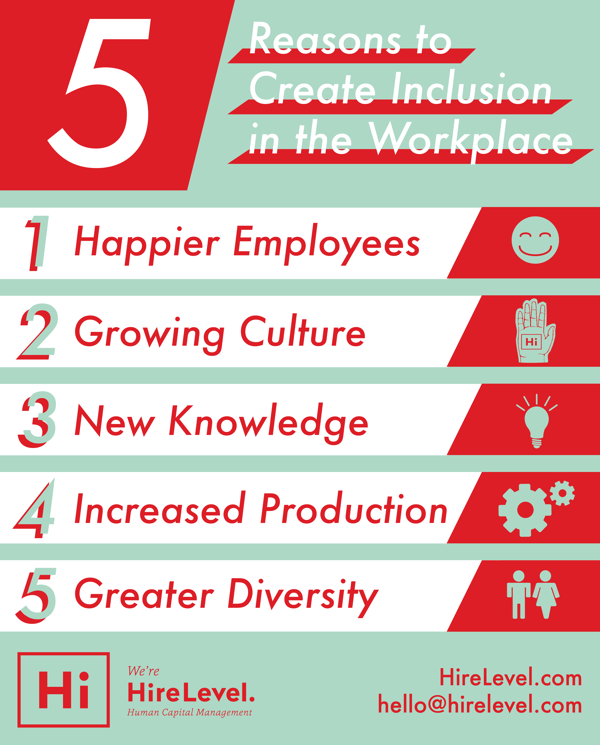How can you foster an inclusive work environment? Creating an inclusive environment is something leaders of teams, both big and small, need to consider so everyone is welcome, involved, and able to share their ideas. And as a team member, it's important to ensure your colleagues feel comfortable during conversations, meetings, etc.
Not only does an inclusive work environment create a better workplace for your team, but it also improves business performance. A study by Josh Bersin, an industry analyst, found that inclusive companies are 1.7 times more likely to be innovative leaders in their market.
Let's demystify inclusivity and look at some tips to foster inclusivity on your team.
What Is Inclusivity?
Inclusivity can mean different things to different people, but this definition of inclusivity sums it up quite nicely.
Inclusivity Definition
Inclusivity is when individuals with different identities and backgrounds are welcomed in a group setting (e.g., company, office, meeting), they are valued members of the group. Not only does inclusion mean these team members feel like they belong, but they are also trusted and relied upon to contribute to the team.
Benefits of Inclusivity
So, what are the benefits of having an inclusive team? This infographic from HireLevel shows some key benefits an inclusive workplace provides.

Source: HireLevel
With an inclusive work environment, the morale and overall happiness of your employees improves. New ideas and diverse ways of thinking are shared across your team, which leads to innovation and increased productivity. Plus, it encourages diversity efforts across your company.
Inclusivity Tips
- Create a transparent and honest culture.
- Be an ally.
- Acknowledge your unconscious bias.
- Develop a remote work policy.
- Create an agenda for meetings.
- Name a meeting facilitator.
Ready to make your team more inclusive? Here are some tips to foster inclusivity on your team.
1. Create a transparent and honest culture.
Difficult conversations are tough, especially in the workplace. When you build a culture where feedback is valued, you'll create an open line of communication between you and your team. This can be done by incorporating feedback into your regular communication and scheduling regular in-person and video chats to have these conversations. With regular conversations, team members will feel more comfortable sharing their thoughts.
2. Be an ally.
Whether you're a leader or an individual contributor, you can be an ally for your colleagues at work. In this TED Talk by Melinda Epler, she elaborates on three simple ways to create a more inclusive workplace:
- Don't interrupt: Take a step back and listen to your coworkers.
- Advocate for underrepresented individuals: Invite them to share their opinion and encourage them to take new opportunities.
- Change someone's life significantly: Commit to making positive changes on your team.
3. Acknowledge your unconscious bias.
What's unconscious bias? It's often identified as any prejudice or assumptions that are made for or against an individual or group. Subtle biases can lead to exclusion. Leaders should ensure all of their team members have access to necessary training, personal development, professional networks, etc. so all individuals or groups are included.
4. Develop a remote work policy.
Whether your company is just getting started with remote work or you have a few employees working remotely either part-time or full-time, a remote work policy will help outline the guidelines to work successfully. Sometimes, remote work can be perceived as a privilege only for those with a specific amount of tenure or more experience. By creating a remote work policy and communicating your expectations clearly, your employees will be empowered to work remotely and see the benefits for themselves. These remote work policy templates are a great place to get started.
5. Create an agenda for meetings.
When scheduling meetings, you can ensure everyone is on the same page by creating a meeting agenda. This makes it easier for people who are more introverted and not as comfortable speaking up. Each team member can prepare ahead of time so they can contribute to the conversation.
6. Name a meeting facilitator.
In meetings, especially for hybrid teams, it can be challenging to ensure everyone is included. Select a member of your team to be a meeting facilitator. Their role is to keep the meeting on track and make sure all participants are included and not overlooked. For example, if participants are joining the meeting virtually, they might be intimidated to speak up. The meeting facilitator can moderate the conversation so participants, both in-person and remote, have the opportunity to share their thoughts and won't be interrupted.
For hybrid meetings, the meeting facilitator is responsible for ensuring the meeting room is properly set up and monitoring the audio and visual connection throughout the meeting. This decreases the likelihood of technical difficulties so everyone can participate, speak, and be heard.
In an inclusive work environment, your team members will feel empowered to contribute their unique perspectives and ideas, and this ultimately leads to a happier and more productive team. To learn more, check out these remote management best practices next.

